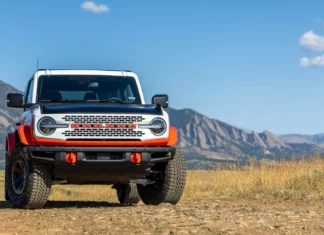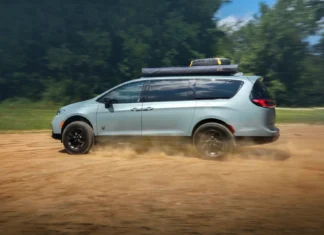The Mini Cooper Clubman was always the odd duck of the admittedly already odd Mini family. Ostensibly based on the old Mini Traveler, the Clubman had an extended wheelbase, which extended the rear greenhouse in a disproportionate way. It was topped off with split rear barn doors and, despite the extra room, it never sold in any real measurable numbers.
For the 2016 model year, the Clubman was completely redesigned from the ground up. Now based on the latest Mini platform, the Clubman’s extended wheelbase was retained, but it gained two more doors and with it much better looking proportions.
With its newfound good looks to go along with its increased practicality, the Clubman’s sales are soaring. It outsold the regular Mini Cooper 2-door and 4-door in June. So it’s about time the Clubman got put through its paces here at TFLcar.
Styling
All Minis are good looking in an odd sort of way. They sort of look like old Minis, but they sort of don’t. They’re more of an homage than a true update, but the neo-retro look works better than in some other retro cars like the VW Beetle and Fiat 500.
The 2016 Mini Cooper Clubman that arrived at my door was dressed in Pure Burgundy metallic paint with a silver roof and mirrors. It’s not the color scheme I would pick, but it’s a tasteful color combination. This car also had the sport package, which adds 18-inch wheels, but apart from that, there’s not much else to differentiate it from other Clubmans.
With the four-door layout (technically six-door with the rear barn doors), the Clubman now has proper proportions and doesn’t just look like a Mini that’s been subjected to the rack. It wears its length well, mostly due to the Mini’s wide stance with short overhangs.
Inside, the Clubman has the same interior as other Minis, with the large circular centerpiece that houses the infotainment system, toggle switches on the roof and at the bottom of the center console, a taut steering wheel and small, watch-like speedometer and tachometer behind the steering wheel that moves with the wheel. The big circle in the middle of the dash is a little over-the-top, but at least it no longer houses the speedometer like in past Minis.
The interior is definitely stylish – the blue leather seats and door trim that don’t match anything else notwithstanding – but the style leaves it ergonomically challenged. Some of those challenges have to do with the usual weird switches and controls that seem to live in all European cars, but a lot have to do with the fact that they wanted to make it look old while still having modern amenities. The toggle switches all look the same, so it takes time to learn what each of them does. At first, I couldn’t find the engine start button, but it was a toggle switch at the bottom of the console near the shifter.
The infotainment system is one of the most confusing I’ve ever used. It has a circular control knob behind the shifter, but it’s not as intuitive as the ones in Mazdas or in lower-end Mercedes-Benzes. The menus and controls aren’t at all intuitive. I had to look at the owner’s manual to figure some things out, only to realize that there’s really no manual for the infotainment system. Something as simple as skipping through songs isn’t easy to do.
The steering wheel controls don’t help. Unlike many other cars that have an easy way to skip forward and backward between songs or radio presets, the Mini makes you scroll through a menu and then choose the song. A simple forward-backward would be much better.
I also found what’s either a missing feature or a bug. When I listen to music, I like to pick a playlist and then shuffle (randomize) the songs. I do it all the time, and I’ve had it work perfectly on all the cars I’ve driven and tested. In the Mini, though, it didn’t quite work as it should.
It starts off fine – when the first song plays, the correct album art and song title are displayed on the screen. But when the first song ends and the second song begins, neither the album art nor the song title change. If I move the control knob, it updates the song title, but not the album art. Then the next song plays, and the album art is two songs behind and the song title is one song behind. Curiously, it works fine when the playlist isn’t shuffled. This is a pretty major bug that BMW/Mini should fix right away.
UPDATE: The issue only seems to happen when the infotainment system is on “split-screen” mode; otherwise it works fine. It’s still an annoying bug that needs to be fixed.
Another annoyance is with the speedometer. It’s right behind the steering wheel, which is nice, and its pocketwatch-like appearance is lovely, but the clear plastic cover is highly reflective. This means that, in almost any light, your reflection stares back at you while you’re driving. I’m no narcissist, so that’s the last thing I want to see. It needs either a hood or cover, or it needs a less reflective surface.
Performance
Motivating this base-level Clubman is a 1.5-liter turbocharged three-cylinder engine making only 134 horsepower, but it compensates by making 162 lb-ft of torque. Power is transferred to the front wheels through a six-speed automatic transmission.
Despite the low power output, the little engine moves the Clubman forward with surprising authority. It runs out of steam near the upper rev range, but it still has enough grunt to allow it to point and thrust through traffic. It also has a raspy, throaty sound that only a three cylinder can make.
The six-speed automatic is a treat, shifting nearly as quickly as a dual-clutch transmission. There are no paddle shifters, but the floor shifter has a manual gate that’s in the proper racing position of forward for downshifts and back for upshifts. Using the manual gate is more than enough fun that the lack of paddle shifters is understandable. Sure, a manual would be even more fun, but the auto is no penalty ‘box.
Ride and Handling
Minis are well known for their handling, and the Clubman doesn’t disappoint. Steering is crisp and sharp, with excellent weight and feel. It’s one of the best electric steering racks I’ve used. With the help of the sport package, which adds in dynamic damper control and 18-inch wheels, the Clubman always feels poised and planted with zero body roll.
Unfortunately, the sport suspension and tires with uber-thin sidewalls take a toll on ride quality, as the suspension jitters over bumps and expansion joints are met with a loud thump. Unless autocrossing is a requirement, the sport package could probably be left off the options list, although it also includes nifty LED lights and sport seats.
Utility
Interior room is tight, but it is the biggest Mini the company ever built, so there is a lot more usable space than the regular Cooper. Long fore-and-aft adjustments on the front seats means that only the tallest need not apply. My 6′-3″ friend fit just fine in the front seat. At 5′-10″, I had no problem getting comfortable, especially as the telescoping steering wheel has the longest travel I’ve ever seen. As a bonus, I was able to sit behind myself thanks to deep cutaways in the back of the front seats.
Behind the rear seats, there’s 17.5 cubic feet of space that expands to 47.9 cubic feet with the seats folded down. Without the optional full-size spare (which is actually a compact spare), there’s an extra bin under the floor that can hold more stuff, but it has to be long and not tall.
This isn’t a ton of space, though. To put it in perspective, a Mazda3 hatchback has 20.2 cubic feet of space behind the seats with 47.1 cubic feet with the seats folded. The Clubman is competitive, but this biggest of Minis isn’t the biggest car in its class. However, it’s plenty usable for a small family, or a couple with a few dogs.
Economy
For a car with a three-cylinder engine, the Clubman doesn’t get the best mileage. The EPA rates it at 25 mpg city, 34 mpg highway, and 28 mpg combined. In its time with me, the Clubman got 25.9 mpg in mostly city driving. The car has an eco mode, but it really makes the car feel gutless. I didn’t keep it on long enough to see if it would make a difference, but I would probably use it again if I were in stop-and-go traffic. There’s also a sport mode, but I didn’t notice much of a difference there either so I kept in in normal mode most of the time.
Value and Competition
The as-tested price of the Clubman was $35,540 including destination. That’s a significant price, and it’s the biggest problem with Minis. They’re just too expensive, so they really offer no value. They start out OK – the base price before destination is $24,100 – but once you add some packages and some a-la-carte options, the MSRP climbs rapidly. This $35k Mini didn’t even have power seats, that would’ve cost an extra $1,250.
There are so many bigger, more powerful, more capable cars you can get for 35 large that the list would be too long to publish, but here are just a few:
Heck, you could buy two Scion iAs for the test Clubman’s list price, and still have a fun car to drive. With a spare.
Summary
- Buy It,
- Lease It,
- Rent It,
- or Forget It,
The 2016 Mini Cooper Clubman gets a Lease It!
The Clubman is a great little car, but its lack of value holds it back from getting a better score. But here’s the rub – despite the ergonomically challenged interior, despite the idiotic infotainment system, despite the formidable price, and despite the brand’s poor reputation for quality, it’s hard to live with one for a few days and not come away wanting to take one home for yourself. Buying a Mini isn’t a rational decision, it’s driven by raw emotion, and on that criteria the Mini gets a perfect score. At least the added room and functionality of the Clubman means that you can use it as a real car, too.
Check out this related TFLcar video of the 2016 Mini Cooper Clubman:
























































